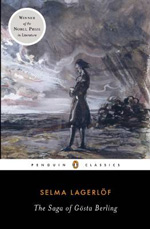

Penguin Classic, paperback, 9780143105909
In 1909 Selma Lagerlöf was the first woman to be awarded the Nobel Prize in Literature. Born in Värmland, Sweden in 1858, Lagerlöf published her first and most renowned novel, Gösta Berlings Saga in 1891. It was first translated into English in 1898. Paul Norlen's new translation for Penguin Classics is the first major translation in over a hundred years, and it is a splendid introduction to Selma Lagerlöf.
We are introduced to Gösta Berling in the novel's prologue as a handsome, charismatic young minister who has fallen into drunken carousing and wild living. Leaving his ministry before he can be defrocked, he becomes a homeless beggar until the Majoress of Ekeby, the wealthiest woman in the area, scoops him up in her charity and gives him a home as one of her twelve Cavaliers, a motley crew of ex-officers, down-on-their-luck squires, musicians and others who spend their days playing cards and drinking.
The time-span of the novel is a year, from one Christmas feast to another. During the first Christmas feast, the Cavaliers betray the Majoress, and she is exiled from her home to wander the roads until the next Christmas when she returns to claim her power and position. The events during the year chronicle, not only Berling's adventures and misadventures, but capture the life of the inhabitants of Värmland from the wealthy iron manufacturers to the farming peasants. The Swedes of Lagerlöf's world are not morose or haunted by piety—they are full of life, lusty, passionate and active, and Berling is a Romantic hero with a streak of Lutheran morality at his core. One of the reasons for Lagerlöf's renown and popularity during her lifetime is that she depicted the Swedish people as they liked to see themselves, unlike her older contemporary, the misanthropic August Strindberg. Selma Lagerlöf celebrated the Swedish landscape and people—perhaps her best beloved work in Sweden is The Wonderful Adventures of Nils (Nils Holgerssons underbara resa genom Sverige, 1906–07), which introduces the geography and history of her native land to children.
The Saga of Gösta Berling moves freely from lyrical celebrations of nature to harshly realistic
descriptions of industry, and on into the realms of folklore and fairytale. Were the book published today,
we might classify it as magical realism. But set in the 1820s, Lagerlöf's novel is really a piece
of historical fiction, nostalgically recapturing a world that is lost to those entering the angst-ridden
world of the 20th century. It is not a particularly intellectually challenging novel, but it is a
fascinating peek into 19th century Sweden, and it is a cracking good read.
